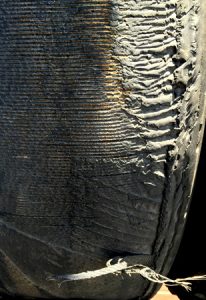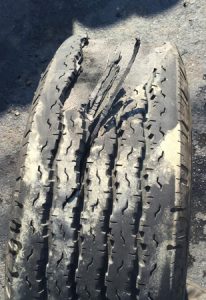
This summer, I was towing my second-hand trailer and brass-era Buick out to the Lancaster, PA area to go train racing. That’s right, our Horseless Carriage Club of America chapter has an annual car show at the Strasburg Railroad that includes racing our cars against a magnificent steam locomotive! A great time for all – if you can get there, that is.
With only a couple miles to go to my exit on the PA turnpike, I heard a loud BANG from behind and looked in my mirror to see shredded rubber flying towards the weeds. Oh happy day, with a lurching trailer to boot. Take a look at the photos of my tire, and you can imagine how thankful I was that the outcome was no worse than a missed outing. After fixing the trailer and getting everything back home, I started looking into trailering safety, and here is what I learned about tires.



First of all, a trailer tire can appear to be just fine, showing good tread depth and seemingly good overall condition. But even though many car trailers are used sparingly, the tires can actually be dangerous because of advanced age-related degradation despite their low mileage. Trailer tires are weakened by age, oxidation, and exposure to the sun’s ultra violet rays. The maximum recommended life of a trailer tire is three to five years. If you have any doubt about the age of your tires, ask an expert at your tire store to read the date codes on the sidewalls. My tires looked great, but were over 15 years old! Replace outdated tires for your own safety as well as your fellow motorists.
Second, be sure to buy TRAILER TIRES for your trailer. They come in bias ply or radial tires, and we again recommend you talk with your tire professional to decide which is best for your purpose and that you follow all of his recommendations regarding size, load capacities, and tire type. Trailer tires are very different than vehicle (car and truck) tires. Vehicle tires must accelerate the vehicle to speed, steer the vehicle, handle braking loads, and deform over road irregularities to maintain tire contact with the road. Vehicle tires do all this yet have flexible sidewalls to give a nice ride for your passengers.
Trailer tires, however, usually have stiff sidewalls and more plies to increase their strength for load bearing purposes and to reduce trailer sway. They are free-spinning, but may also have to transmit braking forces if you have trailer brakes. They must handle side loads and are not concerned with providing a cushy ride. Trailer tires are also specifically designed for trailer wheels, which are different from car or truck wheels. Do not use car or truck tires on your trailer!
Third, because of their stiff sidewalls, trailer tires may appear to be ready to go even if they are grossly underinflated. Underinflated trailer tires are the leading cause of blowouts. Since you cannot tell if your tires are underinflated just by looking at them, check your tire pressures before and during every tow. Check the pressure when the tires are cold. An underinflated tire will get extremely hot and hot tires soften, lose their load capacity, and finally lose their ability to contain high pressure air. Then they blow out.
To avoid this, maintain your trailer tires at their rated pressure, or maximum PSI, as recommended on the tire sidewall. This lets the tire run cooler, support the load better, and results in lower rolling resistance for better gas mileage. Some guys run low pressures in the belief that it gives a softer ride for their collector car load, but this is not recommended. Your collector car has its own suspension to soak up the bumps, and a blowout from low tire pressure may put your entire rig – and you – in jeopardy. Even if you don’t have a blowout, the mushy ride may result in loss of control of the trailer. So air up, and don’t forget to replace the cap on the valve stem!
Fourth, don’t overload your trailer tires. The maximum load is shown on the tire sidewall. Single axle tires can handle 100% of the rated load, but dual axle tires must have their load reduced by 12% below the rating. If you are in doubt, ask your tire professional.
Fifth, the faster you tow, the hotter your tires get. The hotter they get, the less control you have and the more likely they are to fail. A good maximum tow speed is 60 miles per hour. Go faster than that and you run real risk of having a blowout or worse.
Last but not least, always carry a good spare tire of the same size plus the tools you need to safely change the tire. Check your spare’s pressure before every tow when you’re checking the other tires. Take everything you need to jack up the trailer and remove and replace the lug nuts to specification. Take some scrap wood to use under the jack if you encounter soft ground by the side of the road. And for Pete’s sake, be sure you have the right size wrench to remove the nut holding the spare to its mount, or you won’t be able to get the spare off to mount it on the axle! It happens – ask me how I know…
If you have made it this far, congratulations! There is one more thing I want to add regarding insuring your collector car while towing. Some guys drop collision coverage if it is a dedicated, never-driven show car or if the car is under restoration and not drivable. However, if you are towing the car to the paint shop or some other destination, please make sure you have collision coverage on the vehicle. The reason is that even though the car may not be drivable, it can still suffer a collision if it breaks free of its straps while under tow and smacks into the inside of your trailer! Collision coverage only costs a few bucks, so we recommend you just leave it on your policy at all times if you are transporting – as well as driving – your car.
William Hoffer, Director of Marketing
Don’t forget, along with your collector cars, Grundy can insure your tow vehicle and trailer at their agreed value with our MVP insurance products. Check them out here.








Trailer tires sit loaded in one spot, dry rotting, causing steel belts to separate. But since the belt separation is happening on the bottom of the tire, you will probably never see it. Now, through in centrifugal force, which if you have ever watched drag racing, you will see the tires getting larger, that belt separation cannot hold the tire together in these conditions, and boom, tire wipes out the side of your trailer, or, whatever is sitting on your trailer. This is much more expensive than just replacing the tire, because the tire usually blows out in the middle of nowhere, forcing you to pay a premium for a tire replacement, not mentioning the fact, that if one tires bad, the others are right behind it. Store your trailer tires, up off the ground, this keeps the tires ROUND, and allows aging to happen evenly around the tire, not in one hidden spot.
Hello Gordon, Thanks for the info – I think our readers will appreciate it, too. Gordon has a website featuring an interesting product for raising a trailer off the ground called Trailer Legs. Grundy Insurance does not endorse this product, make any claim that it is safe to use, nor can we recommend you use it. However, you may want to check it out and decide if you want to give it a try at your discretion. I raised my trailer for the winter, but did it the old fashioned way with a jack and jack stands. Next year I may try Gordon’s invention. http://www.trailerlegs.com/